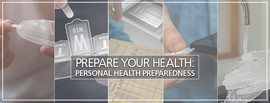|
 SEPTEMBER 2019
|
|
The Michigan Update
Jim Koval, MA, MDiv - DEPR PHEP Local Liaison
A major outage knocked out power across the eastern United States and parts of Canada on August 14, 2003. Beginning at 4:10 p.m. ET, 21 power plants shut down in just three minutes. Fifty million people were affected, including residents of New York, Cleveland and Detroit, as well as Toronto and Ottawa, Canada. Although power companies were able to resume some service in as little as two hours, power remained off in other places for a couple of days. The outage stopped trains and elevators, and disrupted everything from cellular telephone service to operations at hospitals to traffic at airports. 2003 Power Outage >>
Michelle Doebler, MPH – Influenza Epidemiologist – MDHHS Division of Immunization
Ten years have passed since the 2009 H1N1 Influenza Pandemic. This anniversary provides an opportunity to reflect on that event and explore the progress that has been made to prevent seasonal influenza as we enter 2019-2020 season. Each year, the Advisory Committee on Immunization Practices (ACIP), utilizes the most up-to-date research to provide annual recommendations on the use of influenza vaccines for the prevention and control of influenza.1 Many of the technologies, surveillance programs, and developments in influenza prevention created in the wake of the 2009 Pandemic assist the ACIP in these important decisions.2 Click to edit this placeholder text. Influenza Preparedness and Prevention >>
|
|
News & Articles
Alice Frame, MA - MDHHS Disabilities Health Unit Coordinator
Invisible disabilities – disabilities you cannot see or disabilities that are not immediately apparent – are incredibly common. Roughly 10% of Americans have a condition or limitation that can be considered an invisible disability. Invisible disabilities can cause limitations that affect how a person responds to an emergency and the kind of care and assistance he or she will need. The more prepared emergency responders are for people with invisible disabilities, the easier it will be to meet their unique needs. The Impact of Invisible Disability in an Emergency >>
Large-scale events, like tornados and disease outbreaks of recent years, remind us of how important it is to be prepared for what comes after the high winds die down and the rain stops.
A natural disaster or unexpected emergency can severely limit people’s access to food, safe water, medicines, and medical supplies for days or weeks or even longer. Be prepared to protect your family’s health and wellbeing by having the personal needs, prescriptions, paperwork, power sources, and practical skills you need to respond. Preparedness Month Resources >>
|
|
Research
West Nile virus (WNV) is consistently the leading cause of domestically acquired arboviral disease, but other arboviruses cause sporadic cases and outbreaks of neuroinvasive disease. WNV neuroinvasive disease incidence was nearly 25% higher in 2018 than the median incidence during 2008–2017. WNV transmission via organ transplantation was reported for the first time since 2013. The first documented case of Powassan virus transmission via blood transfusion was reported. Health care providers should consider arboviral infections in patients with aseptic meningitis or encephalitis, perform appropriate diagnostic testing, and report cases to public health authorities. Surveillance helps to identify outbreaks and guide prevention strategies. Arboviral Diseases >>
|
|
Tools & Resources

Personal needs: Gather enough food, water, and medical supplies to last at least three days.
Prescriptions: Organize and secure at least a 7- to 10-day supply of prescription medications.
Paperwork: Collect and protect important documents and medical records.
Power sources: Be prepared for the possibility of power outage with emergency light, alternative heat, and backup power sources.
Practical skills: Learn self-help and life-saving skills and lessons.
For more information and tips all month long follow @MIPrepares and @CDCEmergency on Twitter and go to http://www.michigan.gov/prepare for in depth preparedness information.
|
Trainings & Events
Webinar
Sept. 25, 2019
1:30 p.m. - 2:30 p.m.
The Division of Strategic National Stockpile (DSNS) next webinar for public health partners is an overview of the FMS mission, capabilities, and formulary, as well as an orientation to the 50-bed and 250-bed FMS cache configurations, components of an FMS bariatric kit, and facility and logistical support requirements to successfully conduct FMS operations, and components of an FMS bariatric kit.
The webinar is open to all federal, state, local, tribal, and territorial public health and emergency response partners and non-governmental organizations that represent public health and emergency response stakeholders.
To register: MI-TRAIN Course ID# 1086753.
|
|
The Guardian of Public Health is a monthly newsletter from the Bureau of EMS, Trauma and Preparedness (BETP) within the Michigan Department of Health and Human Services (MDHHS). The Guardian aims to provide readers with relevant content on topics that affect the public health of Michigan's citizens and communities. |
|
|
This publication was supported by Cooperative Agreement number 1NU90TP922062-01-00, funded by the Centers for Disease Control and Prevention. Its contents are solely the responsibility of the authors and do not necessarily represent the official views of the Centers for Disease Control and Prevention or the Department of Health and Human Services.
Bureau of EMS, Trauma & Preparedness | 1001 Terminal Rd, Lansing, MI 48906 | 517-335-8150
|
|
|
|
|